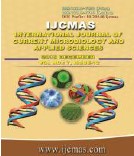


 National Academy of Agricultural Sciences (NAAS)
National Academy of Agricultural Sciences (NAAS)

|
PRINT ISSN : 2319-7692
Online ISSN : 2319-7706 Issues : 12 per year Publisher : Excellent Publishers Email : editorijcmas@gmail.com / submit@ijcmas.com Editor-in-chief: Dr.M.Prakash Index Copernicus ICV 2018: 95.39 NAAS RATING 2020: 5.38 |
Energy analysis is essential for efficient management of the resources in agricultural production. The study was carried out on energy requirement and energy input output relationship of paddy production in konkan region of Maharashtra state. Different farm operations from land preparation to storage were considered for finding the energy consumption in paddy cultivation. Primary data were obtained through field survey. Data were collected from Agronomy field of Balasaheb Sawant Kokan Krishi Vidyapeeth, Dapoli in the year 2017-2018. The results revealed that energy consumed for paddy production was 34789.77 MJ/ha. The net energy, specific energy, energy use efficiency, energy productivity and water productivity for paddy cultivation was found to be 86510.23MJ/ha, 8.69 MJ/kg, 3.49, 0.11 kg/MJ and 0.40 kg/m3. Fertilizers contributed highest share of input energy for paddy cultivation. The contribution of indirect energy (71.54 %) was higher than that of the direct energy (23.27 %). In direct energy, the highest share of diesel fuel (15.37 %) as well as in indirect energy chemical fertilizers (56.71 %) contributed highest share.
 |
 |
 |
 |
 |